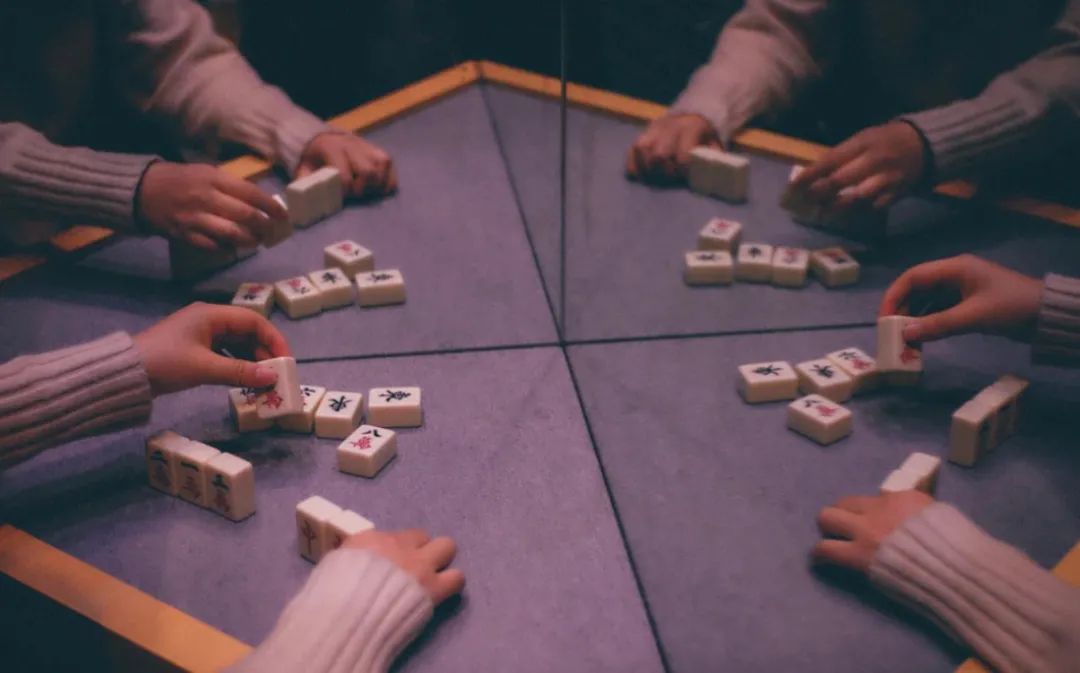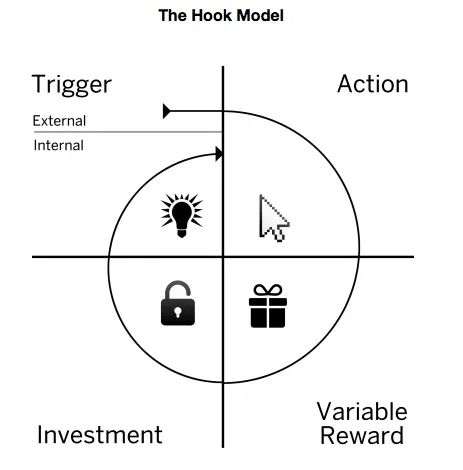From the Hooked addiction model, comprehensively analyze how “Mahjong” makes users addicted.
Editor’s note: This article is from the micro-channel public number (ID: lingzifds) , Author: Reiko z.

Lingzi was particularly obsessed with playing mahjong at home in the New Year epidemic outbreak, plus rereading the “hooked user incentive model” during this time. I want to combine books with the hooked user incentive model to think about the research from the product perspective: “Mahjong” fire? How are users addicted? As students of products and operations, what can I learn from?
Mahjong and hooked incentive models
The Origin of Mahjong
Mahjong, originated from the “leaf play”, Ouyang Xiu’s “Return to the Field” wrote: The Tang people collected books, all made scrolls, followed by leaves …
The leaf in the article is a piece of paper, but this is not a game, but a piece of paper that records values. Later, people found that this piece of paper with words and numbers can be played as a game. The originator’s path to advancement.
Mahjong is the quintessence of China. Every year during the holidays, most of the streets can see a lot of mahjong people. In the current Internet age, online mahjong is also invincible.
Mr. Hu Shi once wrote a “Mahjong”, saying that China opened at least 1 million tables of mahjong every day, and the Chinese were wasting 4 million hours every day. Mahjong is China’s four major harms, and even the culprit of the Qing Dynasty. I do n’t think so. Mahjong ’s 3,000-year history has formed a unique charm and rich cultural connotation through improvement and optimization from generation to generation.
Existence is reasonable, phenomenon is law. It must conform to the trend of the times and human needs.
A while ago, I played online Mahjong with a few friends every day. I won a lot of fun. I wo n’t be reconciled again.
ps: I have lost too much recently, and I temporarily retired from “Matan”.
Hooked model

The book “Powerful Amway”, the second time I read Hooked: How to Build habit-forming product (Hooked: how to build habit-forming product) The problem.
Have you ever thought about why you habitually open WeChat every time you have something to do, why do you habitually open Taobao when you shop online, and why do I just want to play Mahjong?
The answer is “habit”, which is described by the user operation words of the Internet, which is “mind”. The author of this book answers: Behaviors done with little or no conscious thought. That is, products allow users to use your products or services naturally without much thought.
Then, the author of this book created the Hook Model, which has four parts in total:
-
Trigger
-
Action (Action)
-
Variable Reward
-
Investment
Trigger
Trigger is also called “trigger”, which is divided into “external trigger” and “internal trigger” in the book
-
External trigger: information from the outside world that allows you to take action.
-
Internal trigger: invisible and untouchable, it exists in our brain. Emotions, especially negative emotions, such as boredom, irritability, fear, frustration, hesitation, loneliness, confusion, etc. are powerful internal triggers.
1. Social trigger
Mahjong can meet social needs. That is from the perspective of demand. From a practical point of view, if a product forms a social scene, then its vitality will be extended indefinitely. Many games are team battles, and they are the “social attributes” of the friends who join. It is boring to play alone, and it is fun to play with a group of people.
From the trigger point of view, most of the triggers for playing mahjong come from external triggers. Three or five friends call you to play mahjong.In order to make friends “,” Yimai friends “,” a brand sees character “, a group of friends do not know what to play, then come to mahjong; do not know how to test the son-in-law, then come to mahjong.
2. Triggered by specific environment
There are many families that are “Mahjong family”. There is no way. The environment of the family is “playing mahjong”, “ancestral”. Family and friends at home, seven aunts and eight aunts are all playing mahjong, and children will “imitate”. (Ps: The first word I knew when I was a kid was “Zhong”, “Grandpa, touch in red!” I always heard my family tell me this childhood story.
Some friends are triggered by other friends in a specific environment. In a specific environment, they will teach you to play mahjong. From then on, there will be one more brand friend, a new entertainment item, and a novice. There is always a novice halo that can win money.
3. Emotional trigger
For Mahjong, the emotion that can be resolved is-boring, I want to find something to do, I want to find a group of people playing mahjong and talking.
The emotional trigger of Mahjong again includes the feedback from the last Mahjong. The happiness of winning money continues to trigger; the unwillingness of losing money continues to trigger.
Once the trigger of the last Mahjong appears, in fact, it has completely entered the loop of the addictive model, forming a habit, that is, want to play mahjong, do n’t stop me from playing mahjong, I can still touch cards, please call me “Hu one day”.
Action (Action)
Action (Action) is the user’s use of the product and the behavior on the product.
A large part of the hooked model of the author of this book is based on BJFogg ’s Behavior Model: B = MAT——behavior = motivation + Ability + Trigger
Motivation, no motivation, no action. There are various motives behind everything we do. What impressed me most was the “self-determination theory” cited by the author in the book: People have the motivation to pursue happiness and escape pain, seek hope and fear, and desire social identity to avoid social exclusion.
Ability, which is the ability of the user to complete the desired action. The author defines time, money, physical strength, energy, social resistance and psychological migration.
You cannot control a person ’s motives, but you can “lower the ability threshold.”
1. Simplicity of Mahjong
Easy to get started: one card, one table, four chairs, and four people.
You can go to the table, how to do the novice teaching? Come to play a game, 3 minutes, complete the novice introductory study.
Simple rules: formed by drawing cards, playing cards, touching cards, and eating cards: N * AAA + m * ABC + DD, mn can be equal to 0.
The victory is the “hu card”, the rules are so simple.
Easy to operate: Mahjong is “easy to get started” mainly because this game is always looping to draw and play cards. In the design of the product, the ease of operation directly affects the user’s cost.
2. No user costs involved
Money: Playing mahjong is the most expensive licensing fee, and does not involve certain high-denomination capital investment;
Physical strength: As long as you can still touch the cards, you can still play, no more than 4 hours of mahjong, which helps the movement of the arms and fingers;
Energy: Playing mahjong can prevent Alzheimer’s disease, simple card-drawing does not need to waste too much energy;
Social resistance: Occasional work life is a little irritable, playing mahjong can divert attention, and occasionally escape from society;
Mental transfer: Mahjong is actually similar to the bricks when it was a child, and has some similarities with the playing cards afterwards. The cost of adult users is relatively low.
Variable Reward
Changeable remuneration I think is the most important part of the hooked model, which means that users ’actions will bring a variety of rewards.
What is different from the traditional action here is that the reward is slightly different from Variable. It is changeable and uncertain. Human beings have a natural curiosity to explore the unknown. This Mahjong is a very good mapping. , Including everything that makes us addictive.
1. Reward for actual money
The power of Mahjong lies in its rules. Everyone knows what kind of cards can be fooled under the unified rules. “Small hu, big hu, good hu.”
Each card touched can have a new combination. The “Ping Hu” in Mahjong is the most common and the most probable way of the Hu card. It is also a small amount of Hu, but “Da Hu” or ” “Zhuang Shanghu” is not the same, “bar open”, “headshot”, “cai piao”, “seven pairs”, etc., this is the “explosive” double denomination reward. Every time the big names appear, it is just right, the randomness and the sense of anticipation are impressive.
2. Mood rewards
Yes, the anticipation and tension of the big denomination “Da Hu”, as well as the last happiness of seizing the opportunity “Hu Chenggong” and the regret of “missing big names” are rewards for the uncertainty of the mood.
When the reward variable becomes larger, the secretion of dopamine in the brain will also increase, and people will enter a state of concentration, that is, the “heart flow channel” in psychology. Aside from the reward, the process has been given People are happy.
3. Definite satisfaction
More rewards and important is that even if the feedback is satisfied, even if satisfied, the card will look forward to touch and feel, once the “it” comes, that certain satisfactionThe feeling is bursting, the kind of even feedback and satisfaction.
As long as you move your finger, the card you want will come, and the instinct of human hunting will be inspired at this moment. As long as the Hu card has money to take and instantly credit, this is a certainty satisfaction. More than mahjong, people are in pursuit of certain satisfaction throughout their lives.
Investment (Investment)
In the Investment phase, users value expectations of future rewards. The investment here refers to the user’s investment and use of the product itself, which occurs after the variable reward, at this time the user has received the reward given by the product.
The authors of this book mainly divide their input into: content, data, attention, honor, and self-improvement.
1. Time and money investment
The time cost of playing mahjong is investment. If you spend so much time and lose a lot of money in a round of hands, then this investment will be greater. If you want to return to the capital and want to continue to win, you will be more addicted. Too.
Mahjong is a manifestation of Chinese people’s gambling nature, which can be persisted, abandoned, desperate, and can be born out of nowhere.
2. Skill improvement needs verification
Users’ playing skills and skills on Mahjong are becoming more and more fascinating. The more they play, the more powerful they are. They pay a lot of “tuition fees” and learn a lot of new “skills”. Anything is a learning process. Mahjong is not difficult to use. But playing mahjong is a difficult process.
Mahjong is a manifestation of the Chinese nation’s advocacy of vertical and horizontal plans. One person’s win depends on observation and analysis of others.
Written at the end
Small gambling, taking mahjong as a kind of entertaining mind and body puzzle game, occasionally about three or five friends, four people at a table, chatting while playing mahjong, but also close family and friends, but also personally feel The charm of the national quintessence, how good ~
After all, the mahjong quintessence is thousands of years old, and its ideas are worthy of our thinking and learning.
-